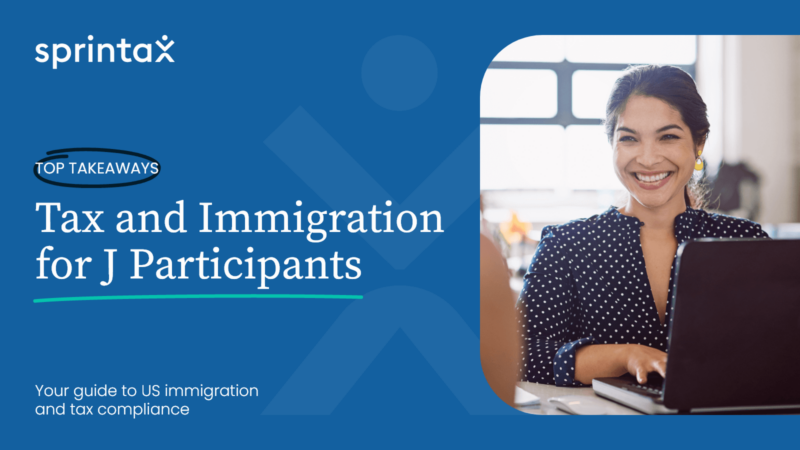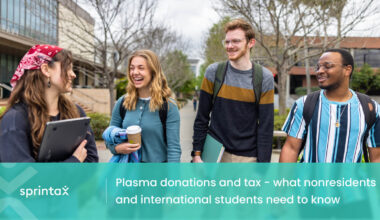At the recent Nonresident Tax Clinic for J-1 visa holders, our panel of industry thought leaders explored the world of tax compliance and outlined the latest developments in rules and regulations for the taxation of J participants in the US.
This fascinating event was perfect for J program participants, J program sponsors, agents, responsible officers, employers of J visa holders or even if you simply have an interest in the J program.
If you missed the Nonresident Tax Clinic and would like to check it out, you can watch it back here.
On the day, a fantastic line-up took part in the event, Kathleen Gasparian, Founding Partner, Gasparian Spivey Immigration and Ryan Ludden, Associate Vice President, Sprintax.
There were a number of key takeaways from the event and we are going to discuss five of the most important learnings here.
In the meantime, if you would like to learn how Sprintax can support you or your organization with US nonresident tax withholding solutions, why not reach out to our team today?
1. J visa – resident or nonresident for tax purposes?
Residency for J Participants can often be a confusing topic!
Most J-1 interns, camp counsellors, and au pairs are considered nonresident for tax purposes – for a set period of time! This is generally 2 years out of the last 6 calendar years (unless you are a J-1 student).
If you have been in the US for longer than 2 years, the Substantial Presence Test will apply! After being in the US for 183 days or more, you will generally be considered a resident for tax purposes, this is calculated through the Substantial Presence Test. A day for Substantial Presence Test counts each day when the person was in the US at 12PM.
Tips from our panel
“Even if you have been present for a single day of the tax year, maybe you arrived on New Years Eve, if you are present for a single day of the tax year, the IRS are going to count that as one of your tax years of presence in the US.” says Ryan Ludden, Associate Vice President, Sprintax.
2. Tax liabilities when on J-1 employment
Federal income tax rates for J-1 employees
- The IRS requires federal income tax withholding on all US source payments to nonresident aliens. The NRA tax rate is 30%. This means that any income paid to a nonresident alien is taxed at 30% except in case it is considered effectively connected to US trade or business. Personal service income paid to a nonresident under J visa is always considered effectively connected income. This means you will be taxed on your wages at graduated rates. These graduated rates range from 10% to 37% from the very first dollar that is earned.
- Nonresidents may also have to pay state tax on income depending on where they live in the US and personal circumstances.
- If an employee fails to provide the necessary paperwork or SSN, then the employer has the right to apply backup withholding at 30% until the necessary paperwork is provided.
Other employment considerations
- Most nonresidents cannot use the standard deduction (outside of Indian students, trainees and business apprentices).
- The personal exemption was waived under Tax Cuts And Jobs Act from 2017, so nonresidents are taxed from the first dollar, unless they have a tax treaty that exempts certain portions of income being taxed.
- Credits for dependents are extremely limited. In some cases, child credits can be used by eligible nonresidents for a qualifying child. These include Canada, Mexico, South Korea and Indian students, trainees and business apprentices.
Tips from our panel
“We see this as a common error when it comes to completing the W4 and getting setup on payroll, we often see that nonresidents are painted with the resident brush, standard deduction is applied and at the end of tax year when filing their tax return they end up with a pretty significant tax bill because they weren’t taxed enough in many cases.” Says Ludden.
3. Tax treaties for J-1/J-2 visa holders
A tax treaty is an agreement between your home country and the US which may allow some J participants to be taxed at a reduced rate or be totally exempt from US income taxes on particular sources of income they receive from within the US.
- The US has income tax treaties with 67 foreign countries that reduces/exempts certain income from tax withholding
- Tax treaties are dependent on a wide range of factors. Whether or not they are applicable to a nonresident is based off a wide range of factors including: immigration status, tax residency, income type, income source and more.
- Only some states honor the provisions of US tax treaties
If you would like to learn more about how to determine income source, check out our whitepaper on the topic here.
Also read:
4. FICA Tax withholding from J-1 visa holders
FICA tax funds Social Security and Medicare programs. A huge 7.65% of an employee’s wages in the US are deducted for FICA, and their employer matches this to bring the total to 15.3%. But, did you know certain groups are exempt from FICA?
As a nonresident J1 student, you should not be charged FICA tax, however it may happen and if so you should apply for a refund, unless you qualify as a resident alien due to previous presence in the US. If FICA taxes are withheld in error, don’t worry – there are ways to claim it back. The two main approaches to have the FICA taxes refunded:
- Ask your employer to amend the quarterly or annual tax return (941) and refund the FICA taxes
- The individual can file a tax claim via Form 843 and 8316 to the IRS, contact Sprintax for assistance!
| Visa Type | F-1 Student | J-1 Student | J-1 Intern | J-1 Researcher |
|---|---|---|---|---|
| Wages | $20,000 | $30,000 | $40,000 | $50,000 |
| US Tax Residency | Nonresident | Nonresident | Nonresident | Nonresident |
| FICA Taxes Withheld in error | Yes | Yes | Yes | Yes |
| FICA Tax % | 6.2% Social security + 1.45% Medicare tax | 6.2% Social security + 1.45% Medicare tax | 6.2% Social security + 1.45% Medicare tax | 6.2% Social security + 1.45% Medicare tax |
| NRA employee portion of FICA taxes that could be withheld | $1,530 | $2,295 | $3,060 | $3,825 |
| Employer’s part withheld in error | $1,530 | $2,295 | $3,060 | $3,825 |
5. Should J-1 visa holders file for 2022?
Every nonresident has some type of IRS filing obligation.
If you are a nonresident for tax purposes as a J-1 visa holder who is an exempt individual, you must complete Form 8843, this is irrespective of income or how many days you spent in the US.
For federal tax returns, you must fill in the form 1040-NR. The rule is simple; if you have earned any taxable income over 0$ you must file a tax return.
Tips from our panel
“There are also very important income documents that you will need when it comes to filing your tax return if you have received income that is typically reported on these documents,” says Ludden. “The first is the most common, that is the W2, so if you have been working, received compensation or wages from your employer during the tax year you will typically be sent the W2 in January of the following year. This will outline all the wages and compensation you earned during 2022 as well as taxes that were withheld on that income.”
Important tax dates for 2023
The 2022 tax filing season is for income earned between 1 January 2022 to the 31 December 2022.
The filing deadline is usually April 15 of the following year, unless that falls on a holiday or weekend, in which it switches to the next business day. In 2023, it is 18 April.
Common J-1 visa nonresident tax scenarios
As we can see, every nonresident in the US has a unique tax profile and no two individuals should be treated the same for tax purposes.
Below we take a look at some common scenarios which organizations are tackling on a daily basis.
Scenario 1: J-1 Trainee
Advik arrived from India on his J1 Trainee visa for the first time in the US in 2022 and started his training program in 2022 at Sony. As per the requirements of his visa, he is granted permission to work and he has already received his SSN.
How should Advik be taxed in 2022?
- Identification: The payroll team at Sony have identified from review of the Advik’s I-9 and immigration documents that Advik is a non-US citizen and needs further processing from a tax perspective.
- Residency: Advik is considered a nonresident for tax purposes, as he is still in his 1st year on J-1 Trainee Visa status and had no previous visit to the US.
- Income Type: Advik is training as a researcher at Sony as part of their training program. Wages paid to him are considered compensation during studying and training (income code 20).
- Tax Treaty Determination: Advik can use the standard deduction of $12,950 and resident tax credits where applicable.
- Tax Forms: Advik does not need to provide an 8233 for the income which is exempt under the Indian tax treaty, however the W-4 will need to be completed in the same manner as that of a resident for tax purposes with the same exemptions and allowances. Indian students or apprentices are allowed to use the standard deduction as well as child and other dependent tax credits where applicable (provided they meet certain requirements).
- Result: At the end of the year Advik should receive just Form W-2, but the standard deduction allowance is applied in the calculation of the income tax – just as would be for a tax resident as it is a condition of the Indian tax treaty. As a nonresident he is exempt from paying FICA and FUTA taxes.
Tips from our panel
“It’s very important that Advik is aware of what he can and can’t do from an employment perspective,” says Ludden. “There’s a big difference between income and what counts as work. Working without authorization in the US, could be a violation of what your non-immigration status says. This may mean you can’t change status here in the US or it may also mean you can’t adjust your status to permanent residence. It’s really important that you know exactly what the rules are and that you stay within those rules.” Gasparian added.
Scenario 2: J-1 Teacher
Antoine arrived from France on his J-1 Teacher visa for the first time in the US in 2022 and started his work as a teacher at Trinity School in 2022. Antoine was invited by the school and the school is a recognized educational institution. As per the requirements of his visa, he is granted permission to work and he has already received his SSN.
How should Antoine be taxed in 2022?
- Identification: The payroll team at Trinity School have identified from review of Antoine’s I-9 and immigration documents that Antoine is a non-US citizen and needs further processing from a tax perspective.
- Residency: Antoine is considered a nonresident for tax purposes, as he is still in his 1st year on J-1 Teacher Visa status with no previous visits to the US.
- Income Type: Antoine is teaching at Trinity School. Wages paid to him are considered compensation for teaching and research (income code 19).
- Tax Treaty Determination: Antoine can exempt all his income from teaching from tax for the first 24 months, as long as Antoine is compliant within the requirements of his visa.
- Tax Forms: Antoine must provide Form 8233 for the income which is exempt under the France tax treaty and the W-4, labelled NRA, for any income which is not paid for teaching. Income covered by the tax treaty is taxed at 0% all dependent personal service income is taxed at the graduate rate for federal tax purposes.
- Result: At the end of the year Antoine should receive Form 1042-S with the income covered by the tax treaty and Form W-2, only if he has dependent personal services income that is not covered by the treaty. As a nonresident he is exempt from paying FICA and FUTA taxes.
Scenario 3: J-1 Work and Travel
Alena arrived from Belarus on her J-1 Work & Travel visa for the first time in the US in 2022 and started her work as a ski lift operator at Beaver Creek in January 2022. As per the requirements of her visa, she is granted permission to work and she has already received her SSN.
How should Alena be taxed in 2022?
- Identification: The payroll team at Beaver Creek have identified from review of the Alena’s I-9 and immigration documents that Alena is a non-US citizen and needs further processing from a tax perspective.
- Residency: Alena is considered a nonresident for tax purposes, as she is still in her 1st year on J-1 W&T Visa status, with no previous visits to the US.
- Income Type: Alena is working as a ski lift operator. Wages paid to her are considered compensation for dependent personal services (income code 18).
- Tax Treaty Determination: Alena can exempt all of her income from personal services from tax, as long as Alena is compliant within the requirements of her visa and is present in the US for less than 183 days in the calendar year.
- Tax Forms: Alena must provide Form 8233 for the income which is exempt under the Belarus tax treaty and the W-4, labelled NRA, for any income which is not paid for personal services. Income covered by the tax treaty is taxed at 0% all other income is taxed at the graduate rate for federal tax purposes.
- Result: At the end of the year Alena should receive Form 1042-S with the income covered by the tax treaty and Form W-2, only if she has income that is not covered by the treaty. As a nonresident she is exempt from paying FICA and FUTA taxes.
J-1 visa Tax FAQs
Q. What does the standard deduction mean for J-1 visa holders?
A. Standard deduction allows you to exempt your first $12,950 for the 2022 tax year from tax withholding.
Q. Does the standard deduction apply to all J1 employees?
A. Most nonresidents on J1 visas cannot claim the standard deduction. The exception here would be Indian students and trainees, who can claim the standard deduction. If you’ve been here long enough to be deemed a resident for tax purposes, then you would be eligible to claim the standard deduction.
Q. I did not get a social security number, does this matter?
A. Sometimes you can be assigned a number, but your card can take months to arrive. You need a social security number if you are earning income in the US.
Q. How does a participant from a J-1 work and travel program on their 3rd year file their taxes?
A. On the Sprintax Returns software you can take a free residency for tax purposes determination. This will confirm whether you have passed the substantial presence test. If you have passed and are deemed a resident for tax purposes, then you can file as a resident for tax purposes.
Q. I am J-1 student who participated in the work and travel program USA 2022. If my tax refund is successfully completed, how can I transfer my refund to my home county?
A. Do you still have your US bank account open? The IRS will usually give the option of a check or US bank account when receiving refunds. It will, however, depend on your circumstances whether you will be due a tax refund or not. The most important thing is to make sure you file to ensure you are tax compliant
Q. Do you help with the 8233 form?
If you need help with the 8233 form we can certainly help. Our system, Sprintax Forms, can be used to generate any pre employment tax forms that are relevant to you and your personal tax position.
Connect with Sprintax
If you would like to learn more about how Sprintax can support you, we would be happy to discuss our tax solutions with you!
Partner with Sprintax
To learn more about the benefits of partnering with Sprintax to support your nonresidents with their US tax requirements, simply contact us at partners@sprintax.com today.








